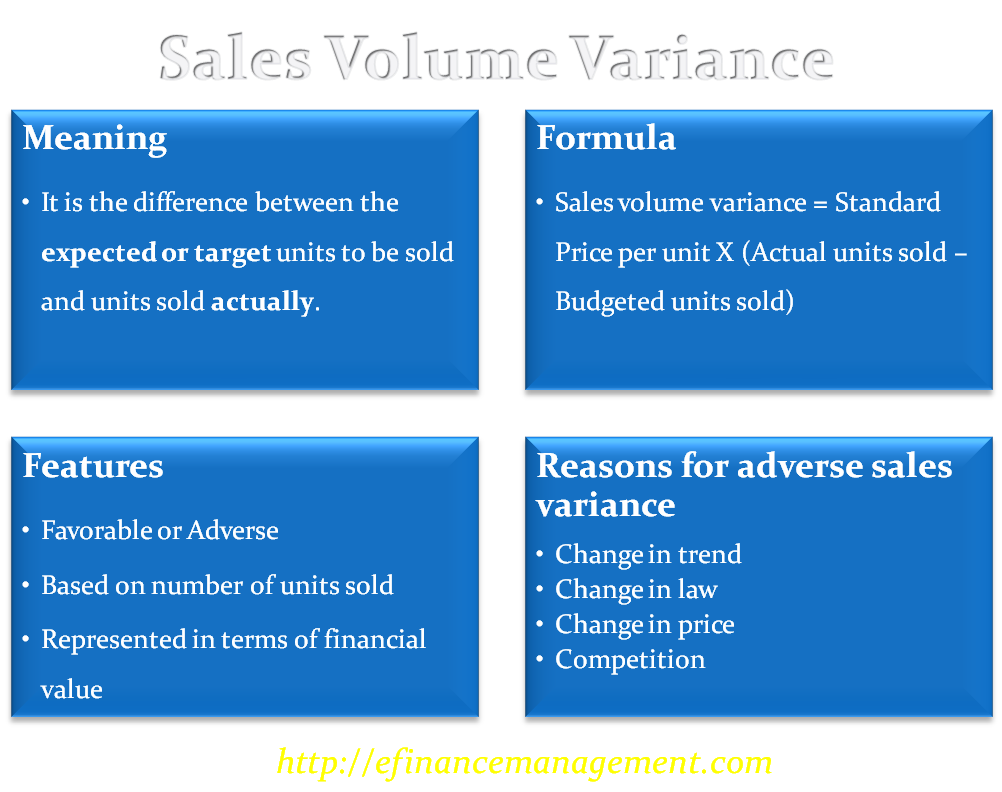Sales volume variance (or Sales quantity variance) is nothing but the dollar variance in total sales as a result of ‘over or underachievement of sales numbers”. The mathematical representation of the same is as follows:
Sales Volume Variance = Standard Price per Unit * (Actual Units Sold – Budgeted Units Sold)
It is the difference between the target selling units as per budget and units actually sold. The resultant figure is then multiplied by the standard selling price of the product. It is also referred to as sales quantity variance.
All the growing organizations should follow the best practices of budgeting. One such important practice is standard costing. The management sets the standard cost, selling price, production volume, and sales volume. This variance is a part of the standard costing analysis.
Meaning
As the name indicates, sales volume variance is analyzed based on the volume. i.e., the number of units sold. It is the difference between the target units (defined in the budget) to sell and the units actually sold. The standard selling price is multiplied by the difference between expected and actual units to arrive at the variance value due to variance in selling quantity.
Also Read: Sales Quantity Variance
Sales volume variance is also referred to as sales quantity variance. It is nothing but a subcategory of sales value variances. A sales value is a result of Selling Quantity * Selling Price. Logically, an actual sales value can vary from a budget only when there is a variation from the budget either in “Quantity of Products Sold” or “Selling Price per Unit.” So, the overall sales value variance is subdivided into the following two variances.
- Sales price variance
- Sales volume variance
Formula
Sales volume variance = Standard Price per unit * (Actual units sold – Budgeted units sold)
Explanation
Based on the past trends, the projected number of units to be sold is derived. Further, the marketing team also derives the projected demand based on the market scenarios. There are a number of factors that affect the sales volume.
The management sets the standard price. The accountant of the organization provides the actual number of units sold.
Features
- The sales volume variance is based on the number of units sold by the organization.
- It can be either favorable or adverse. Accordingly, favorable sales volume variance indicates the sales volume is achieved or exceeded. On the contrary, adverse sales volume variance indicates sales volume not achieved.
- Thus, favorable variance indicates overperformance, and adverse sales volume variance indicates underperformance.
Example
As an illustration, ABC transformers ltd manufactures the transformers. The management has set an annual target sale of 400,000 units of transformers. The standard price of the transformer is USD 200.
Scenario 1) Calculate the sales volume variance if the actual number of units sold is 380,000.
= USD 200 (380,000 units sold – 400,000 units expected to sell)
= USD 200 (20,000 units) = USD 4,000,000 unfavorable or adverse
Scenario 2) Calculate the sales volume variance if the actual number of units sold is 430,000.
= USD 200 (430,000 units sold – 400,000 units expected to sell)
= USD 200 (30,000 units) = USD 6,000,000 favorable

How Does it Help in Decision Making?
The sales volume variance is an important management tool. It helps the management to assess the effect of sales volume on profitability.
Thus, favorable variance indicates the marketing team is performing as per the target, and unfavorable variance indicates that it is not performing as per the target set by management.
Also Read: Sales Value Variance
Accordingly, unfavorable sales volume variance helps in introspecting the factors which led to the low sales volume. Although, the analysis may vary from industry to industry. As an illustration, the number of units of air conditioners sold in summer shall obviously be higher than in the other two seasons. Hence, while setting up the standards, one has to consider these facts in mind.
Reasons for Adverse Sales Volume Variance
Now let us study the possible reasons for adverse sales volume variance. The factors responsible for adverse sales volume variance may be as below.
Change in Trend
Due to advancements in technology, there are changes in the taste and preference of the customer in the market. As an illustration, if the company introduces a new and advanced version of the mobile device, it affects the sale of the previous version adversely. Accordingly, because of the change in customer preferences, customer shifts to a new and improved product. This is the cannibalization of the product.
Change in Law
Sometimes, a change of law also may affect highly a drop in the sales volume. For example, the foreign trade policy has changed, and the government has restricted to the export of certain products. It affects the export sales volume adversely. Accordingly, the variance will be adverse.
Change in Price
If the production cost increases, the management may decide to increase the selling price of the product. As the law of demand suggests, the price and volume have an adverse relationship. Hence, if the price increases, the volume automatically drops.
Competition
It may so happen that the competitor launches a new product in the market. It affects the target volume adversely. Accordingly, it results in adverse variance.

